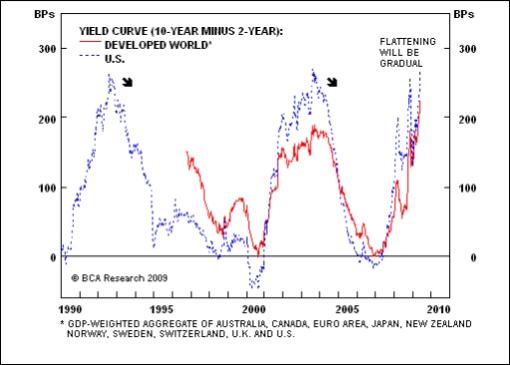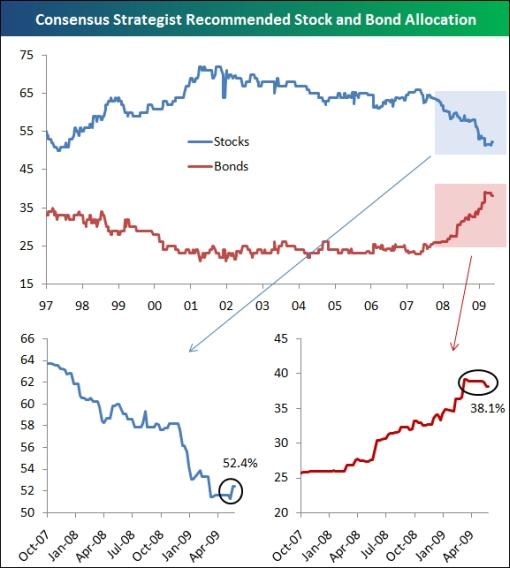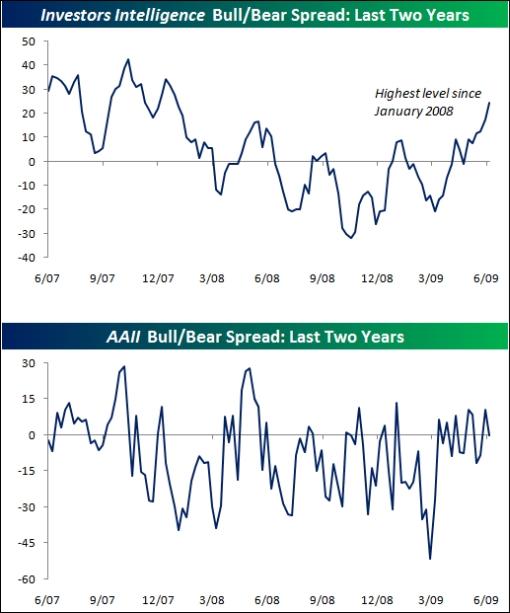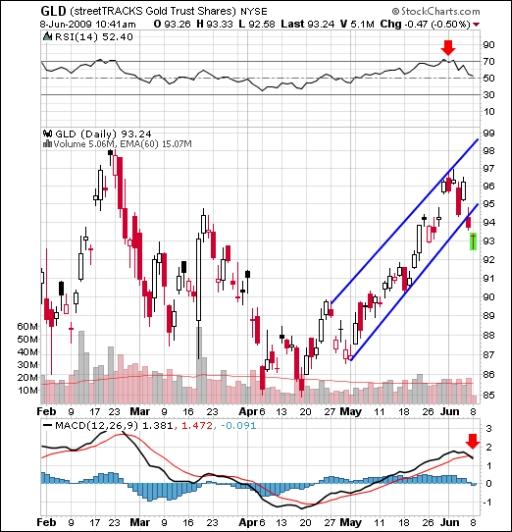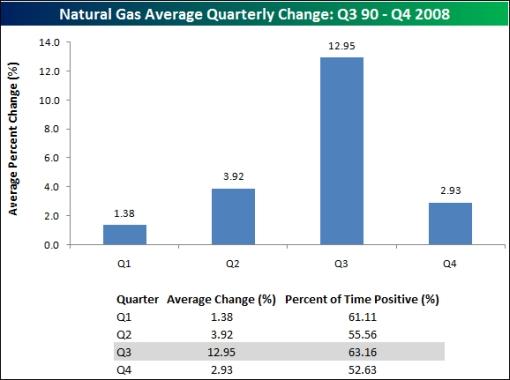Interest Rate Hikes Coming as Investors Return to Risky Assets
Interest-Rates / US Interest Rates Jun 14, 2009 - 02:07 PM GMT Bloomberg: Pimco says “rate hikes will be some time in coming” “Pacific Investment Management Co., which runs the world’s biggest bond fund, said the economic outlook ‘looks bad’ for most of the world and central banks will refrain from raising interest rates.
Bloomberg: Pimco says “rate hikes will be some time in coming” “Pacific Investment Management Co., which runs the world’s biggest bond fund, said the economic outlook ‘looks bad’ for most of the world and central banks will refrain from raising interest rates.
“‘Rate hikes will be some time in coming,’ Andrew Balls, a managing director for the company in London, wrote in a report on the company’s web site.
“Signs of recovery in economies around the globe point to a slower pace of decline rather than recovery, Balls wrote. The outlook over the next three to five years is for ‘weaker global growth and especially weaker growth in the developed countries,’ he wrote.
“The report helped ease speculation the Federal Reserve is moving closer to raising rates, bringing a pause to the biggest surge in US two-year yields in eight months. Fifteen of the 16 US primary dealers that trade with the Fed surveyed by Bloomberg News said they don’t expect the central bank to raise the target rate for overnight loans between banks this year.
“The US economy probably will emerge from recession by September, Nobel Prize-winning economist Paul Krugman said yesterday in London. US job and manufacturing losses both slowed in May, government and Fed figures show.
“Traders see a 62% chance the Fed will raise its target rate by its November meeting, based on futures on the Chicago Board of Trade. The odds were 26% a week ago.”
Source: Wes Goodman, Bloomberg, June 9, 2009.
Bloomberg: Bernanke’s conundrum “The biggest price swings in Treasury bonds this year are undermining Federal Reserve Chairman Ben Bernanke’s efforts to cap consumer borrowing rates and pull the economy out of the worst recession in five decades.
“The yield on the benchmark 10-year Treasury note rose to 3.90% last week as volatility in government bonds hit a six-month high, according to Merrill Lynch & Co.’s MOVE Index of options prices. Thirty-year fixed-rate mortgages jumped to 5.45% from as low as 4.85% in April, according to Bankrate.com. Costs for homebuyers are now higher than in December.
“Government bond yields, consumer rates and price swings are increasing as the Fed fails to say if it will extend the $1.75 trillion policy of buying Treasuries and mortgage bonds through so-called quantitative easing, traders say. The daily range of the 10-year Treasury yield has averaged 12 basis points since March 18, when the plan was announced, up from 8.6 basis points since 2002, according to data compiled by Bloomberg.
“The rise in borrowing costs in the face of record low interest rates, Fed purchases and a contracting economy is the opposite of the challenge Bernanke’s predecessor, Alan Greenspan, confronted when he led the Fed.
“In February 2005, Greenspan said in the text of his testimony to the Senate Banking Committee that a decline in long-term bond yields after six rate increases was a ‘conundrum’. At the time, he was trying to keep the economy from overheating and sparking inflation. Now, Bernanke may be facing his own.
“Bernanke and other Fed officials say the improved economic outlook and rising federal budget deficit are the catalysts for higher borrowing rates, and see no need to increase purchases of bonds. Plus, the Fed has succeeded in shrinking the gap between 10-year Treasury yields and 30-year mortgage rates to 1.77 percentage points from 3.37 percentage points in December.
“‘To the extent yields are going up because the economic outlook is brighter, the answer would be, don’t do anything,’ Federal Reserve Bank of New York President William Dudley said in a transcript of an interview with the Economist last week.”
Source: Liz Capo McCormick and Dakin Campbell, Bloomberg, June 8, 2009.
BCA Research: Global yield curve strategy “It is likely to be at least until the second half of 2010 before central banks are in a position to tighten, and even then rate hikes will be gradual. Thus, it is probably about six months too early for investors to bet on a material flattening in government bond curves.
“During the last recession, the 2/10 Treasury slope peaked in August 2003 but did not begin to steadily flatten until early 2004, a few months before the Fed began its tightening campaign in June of that year. Last week, Atlanta Federal Reserve Bank President Dennis Lockhart outlined the unusual scenario that if faced with inflation, the Fed could potentially increase the target funds rate even as it continued to pursue quantitative easing.
“Although technically possible, thanks to the recent policy of paying interest on bank reserves, this outcome is highly unlikely. Rate hikes will be politically impossible in the near term. It would be far easier to gradually and quietly unwind monetary stimulus in the reverse order that it was implemented, i.e. by selling long-term securities. Bottom line: Government yield curves are at cyclical extremes but a material flattening phase may still take until late 2009 or early 2010.”
Source: BCA Research, June 10, 2009.
Moneynews: Pimco recommends foreign, short-term bonds “Money management firm Pimco recommends foreign and short-term bonds, as huge monetary and fiscal stimulus raise the threat of inflation.
“Those views are part of the bond giant’s secular outlook, which covers the next three to five years.
“Deflation represents the main risk in the short term and then inflation in the long term, the outlook says.
“The deflation concern stems from ‘the severity of the collapse in global demand and the resulting large gap in actual versus potential output’, the report states.
“‘Inflation risks will come to the fore later … as potential output becomes more constrained … and policymakers struggle to withdraw the massive levels of monetary and fiscal stimulus that have recently been introduced.’
“The case for foreign bonds: ‘US bonds, especially Treasuries, will face greater sovereign risk, as the US debt burden mounts and inflation expectations start to rise later [on],’ the report states.
“As for short-term bonds, their yields ‘are likely to be anchored near current low levels for a longer period than what is now priced into forward interest rate curves,’ the study says.
“‘Policymakers in many countries are likely to overstay with loose monetary policy.’”
Source: Dan Weil, Moneynews, June 9, 2009.
Bloomberg: Russia may swap some US Treasuries for IMF debt “Russia may switch some of its reserves from US Treasuries to International Monetary Fund bonds, the central bank said today. The comment drove Treasuries and the dollar lower.
“Alexei Ulyukayev, first deputy chairman of Russia’s central bank, said some reserves may be moved from Treasuries into IMF debt, reiterating comments made last month by Finance Minister Alexei Kudrin. Ulyukayev’s remarks were confirmed by a Bank Rossii official who declined to be named, citing bank policy.
“About 30% of Russia’s international reserves, which stood at $401.1 billion on May 29, are currently held in Treasuries, Ulyukayev said. Kudrin said on May 26 that Russia planned to buy $10 billion of IMF bonds using money from its foreign reserves.
“The IMF securities would give countries a different way to contribute to the fund and are unlike traditional bonds because they pay an interest rate pegged to the IMF’s basket of currencies, known as Special Drawing Rights.
“China is expected to buy as much as $50 billion of the bonds, IMF Managing Director Dominique Strauss-Kahn said yesterday.
“The IMF, which has rescued economies from Pakistan to Iceland in the past year, has never issued bonds before and is seeking more cash to finance loans and aid to member countries during the worst economic slump in the fund’s 64-year history.”
Source: Alex Nicholson and Dakin Campbell, Bloomberg, June 10, 2009.
Eoin Treacy (Fullermoney): Munis look overextended “Municipal bond yields hit accelerated peaks in October as panic over the fate of the financial system gripped markets. However, investors began to assume that states would not be allowed to default soon afterwards and yields began to fall. This has led us to a situation where some states municipal bonds have moved from the highest yields in a generation to some of the lowest in less than a year.
“Most municipals peaked in December as Treasury yields began to rise. Over the last decade most states have yielded less than Treasuries and spreads are quickly heading back below zero. This suggests a return to more ‘normal’ conditions and that the ‘low hanging fruit’ in the municipal markets have been picked.
“In absolute terms, there is significant potential for municipals to pull back from their present overbought condition in terms of price, making discipline with regard to stops on long positions a sensible strategy for traders.”
Source: Eoin Treacy, Fullermoney, June 9, 2009.
Bloomberg: Berkshire bought municipal bonds amid higher yields “Warren Buffett’s Berkshire Hathaway doubled its municipal-bond holdings in nine months amid record swings in the value of the securities that the billionaire investor labeled ‘unthinkable’.
“Berkshire increased its investment in debt issued by state and local governments to $4.05 billion as of March 31 from $2.05 billion on June 30, 2008, the Omaha, Nebraska-based company said in regulatory filings. Berkshire added $1.09 billion to the bet in last year’s third quarter and $985 million in the first three months of 2009.
“Buffett’s firm bought municipal bonds while scaling back stock purchases and as its cash position fell to the lowest level in five years. As Berkshire was adding to the stake, hedge funds, mutual funds and other institutions that use borrowed money to boost returns were forced to sell holdings to meet margin calls and investor withdrawals, especially after Lehman Brothers collapsed in September.”
Source: Erik Holm and Jeremy Cooke, Bloomberg, June 9, 2009.
Anne Breen (Standard Life): Commercial property - confidence returning “Confidence is returning to the commercial property market, with the UK furthest advanced in the cycle, according to Anne Breen, head of property research at Standard Life Investments.
“She points out that the collapse in commercial property that started in the summer of 2007 has so far been the swiftest downturn in the sector’s history, reflecting the deep global recession, the financial crisis and a turnaround in sentiment.
“‘However, the early months of 2009 have seen more stability in transaction yields in select markets, sizeable capital raising and renewed investor interest in this asset class,’ she says.
“‘While returns are likely to come under further downward pressure in the next 12 months, longer-term investors, particularly those with equity, should begin to analyse the property market carefully.’
“Ms Breen says that while the UK’s practice of monthly valuations, compared with much less frequent practices in other countries, exposed the excesses in 2007, it could begin to give confidence to those investors looking to re-enter the market at the bottom of the cycle.
“‘The UK market was one of the first to begin the process of repricing and looks to be furthest advanced in the global cycle,’ she says.
“‘Over a three-year time horizon, UK commercial property returns are likely to outperform cash.’”
Source: Anne Breen, Standard Life (via Financial Times), June 9, 2009.
Bespoke: Strategists turn slightly more bullish “Below we highlight the consensus strategist recommended stock and bond allocation as measured by Bloomberg’s weekly Wall Street strategist survey. After stocks began dropping in late 2007, strategists followed by lowering their recommended stock allocation. By the time the market bottomed in March, strategists had lowered their recommended stock allocation down to just 50%, which was a low for the 12-year survey. Since the market has now rallied 40%, strategists have just recently bumped up their target stock allocation to 52.4%. Better late than never, right?
“On the other hand, strategists had been increasing their recommended fixed income allocation since mid-2007 as well. Their target bond allocation reached a record high of 39.1% in early March, but since then it has dropped just a bit down to 38.1%. If investors were following these recommendations by selling stocks during the market decline and buying Treasuries, they can’t be very happy now that Treasuries are tanking and stocks are up.”
Source: Bespoke, June 11, 2009.
MoneyControl: Marc Faber - high risk in entering equities now “Marc Faber, investment guru, www.gloomboomdoom.com, sees a high risk in entering equities now. ‘This is not a good time to enter equities, except for traders.’
“He has booked some profits in Asia and finds valuations there reasonable.
“According to Faber, India has good growth potential, but was quick to add that economic, political uncertainty remains.
“He does not see attractive entry points for commodities currently.
“Q: In the last few days, global markets have sort of been ranging. Do you see this as a consolidation before another leg of the upmove or is it just tiring out?
“A: I would say that the entry point for people who want to buy equities around the world is a high risk entry point because the global economy has bottomed out. There is little potential to grow very strongly. So, there will be disappointments in terms of earnings in the second half of 2009. The gravy is a bit out of markets. India was below 8,000 on the Sensex and has gone up almost 100%. I don’t think it is a very good time to make an entry into the markets except for traders.
“Q: Till Friday last week, the Dow had almost reversed all its losses in 2009. How would you map the second half of this year?
“A: In the long-term, the dollar would be a weak currency. But we have a lot of volatility and can go either way. No paper currency is very desirable. That is the problem.
“Q: If you had positions in Asian equities at this point, would you be taking profits or would you remain invested?
“A: I have taken some money off the table. In Asia, we have lots of stock markets and lots of stocks that have reasonable valuations. I wouldn’t say very cheap, but reasonable valuations. If you have a long-term time horizon and have cash flow whereby you can buy more shares if they should go down, then I would say hold them. But as a trader, I think as of today I would rather sell than buy.
“Q: Where does India fit-in in that valuation spectrum? Do you agree with the theory that has been put forth that India now deserves a premium to other emerging markets or maybe even Asian markets?
“A: I think that India has of course good growth potential, but there are still lots of uncertainty, both political and economic. As a trader, I would rather sell India than buy it. But as a long-term investor, I would hold here in India.
“Q: Do you think commodities are also about to top out? If you look at crude and even metals, would you be taking profits here if you had positions?
“A: Yes, I have had positions. Many resource stocks have more than doubled from the lows. Some have even tripled. I don’t think that it is a very attractive entry point to buy these commodities and commodity-related stocks.
“Oil is up almost 100% from the lows. The demand for oil is still rising but not as much as before. There is plenty of flight. So, I just don’t think it is a very good time to buy.”
Source: MoneyControl, June 9, 2009.
Bespoke: Investors slowly becoming more comfortable with the rally “While some measures of sentiment still show that investors have been slow to embrace the equity market rally, other measures are showing that they are now more comfortable with it. For example, the weekly survey of newsletter writers by Investors Intelligence shows that the spread between bulls and bears is at its widest level since January 2008 (47.7% bulls versus 23.3% bears). However, while Investors Intelligence is showing relatively bullish levels of sentiment, the AAII survey of individual investors is still dead even, with an equal number of bulls and bears (39.35%).”
Source: Bespoke, June 11, 2009.
Bespoke: S&P 500’s new trading range above 200-day moving average “The S&P 500 looks to be forming a new trading range between the 920 and 950 levels. As shown below, the index has now traded down to the low 920s twice in the last several trading days before rebounding. This level was also the peak of the prior rally in the month of May. Coincidentally, 920 is around the current level of the 200-day moving average, so we would expect this level to act as support going forward. While 920 is acting as support, 950 is currently the main level of resistance. Over the last several days, rallies have run out of gas as the S&P 500 approached this level. Even today’s late day surge looks to have hit a wall when the S&P 500 hit an intraday high of 946.” 
Source: Bespoke, June 8, 2009.
Financial Times: Emerging market equities outperform west “The resurgence of emerging markets this year has reignited a belief in decoupling - the theory that these economies can continue to grow strongly in spite of a sharp slowdown in the developed world.
“Emerging market equities have dramatically outperformed their developed world peers since the start of the year, accelerating since risk appetite began to improve in March.
“The FTSE emerging markets index has risen 41.1% since the start of the year and 60.8% since the beginning of March. This compares with a rise for the FTSE All World developed markets index of 7.2% since the start of the year and 31.4% since the start of March.
“Jim O’Neill, chief economist at Goldman Sachs, expects China and India to grow strongly this year in defiance of recession in most rich nations.
“Mr O’Neill said he believed this was because of a structural shift in the world economy that was seeing the biggest emerging nations benefit from continued growth in domestic consumption.
“‘Contrary to widespread expectations, the chances of China showing growth of more than 8% despite the world crisis are quite high, and the markets are signalling that India’s election results raise the possibility of more reforms there,’ he said.
“‘Over the next five years, there is a genuine chance that both China and India could show domestic demand growth of 10% at the same time.’
“However, some analysts warned that emerging markets relied on the US consumer for their health.
“Nigel Rendell, senior emerging markets strategist at RBC Capital Markets, said: ‘The emerging markets are a geared play on the developed world. If you look at the main emerging economies, it is only really China and India that are continuing to grow strongly.’”
Source: David Oakley, Financial Times, June 7, 2009.
My Finances: Investing in Africa “Investors looking at Africa and wanting to use their cash to help developing communities are often put off by perceived instability in the continent.
“But could people in the UK use their money to help nations in Africa and still see a profit? Daniel Barnes investigated investing in Africa.
“Roger Whitcomb, director of InfraCo which sets up projects in Africa, preparing the ground work so larger investors can have a sturdy foundation, explains caution is needed.
“‘To invest in Africa, you need to be brave and well informed.’
“He explained the current financial crisis may well be a hiccough for Africa, but at the moment it has stopped investment.
“InfraCo funds the early higher risk stages of infrastructure development, with projects in Cape Verde, Uganda and Zambia among others developing wind power, irrigation and power generation projects.
“However, Mr Whitcomb explained there were now problems raising finance, as banks only seem to have an ‘on and off switch’.
“But he maintains positivity, but a major concern he raises is the stability of governments.
“‘We need robust governments to be confident that the world will not change and if you make an awful lot of money, it will not be taken away.
“‘You have to be very wary where social capital and governance [indices] are low.’
“He described Nigeria in recent years as being ‘a nightmare’, while countries such as Cape Verde were much better.
“Investing in Africa is not something you can dip in and dip out off.
“For consumers looking to invest in Africa there are a number of funds that look at the continent. But investors are warned to be prepared for volatility.
“Meera Patel, senior analyst at Hargreaves Lansdowne, explains: ‘There are some great investment opportunities around, but the problem is Africa is still labelled for having political instability and corruption.’
“However, she explains many companies are seeing economic growth and there are improvements in corporate governance being made.
“Mark Mobius, fund manager of the Templeton Emerging Markets Investment Trust (TEMIT), explains one of the main dangers of investing in Africa is a ‘lack of liquidity’.
“‘In a number of markets there is not enough turnover to enable meaningful investments without moving the price, and secondly, there is lack of custodial facilities - in some countries foreign custodial banks can’t find good local counterparts to safe keep securities.’
“He maintains a warning.
“‘I would not say that Africa suffers more volatile conditions than other parts of the world. However, there definitely are political and economic problems which investors should understand and prepare themselves for.’”
Source: My Finances, June 9, 2009.
Richard Russell (Dow Theory Letters): Dollar’s death cross “The Cross-over - Below is the US’s current ‘problem child’. And yes, it’s the fading ‘almighty dollar’. The Dollar Index is shown below on the daily chart. After its recent three-month collapse, the dollar is oversold and ready to rally a bit. But now the 50-day MA has crossed below the 200-day MA, the ‘death cross’. The cross-over point will represent a strong resistance level on any dollar rally.
“The evil progression - a sinking dollar puts pressure on bonds. Declining bonds drive interest rates higher. Rising interest rates mean rising mortgage rates. Higher mortgage rates puts pressure on the purchase of new homes. Housing represents collateral for almost everything in the US economy.”
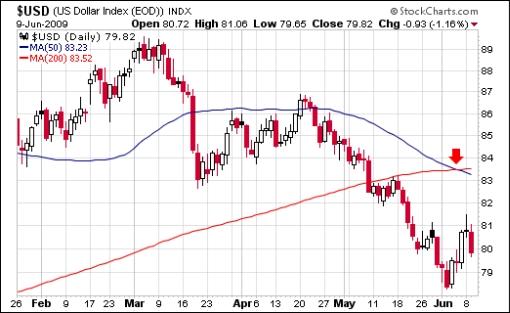
Source: Richard Russell, Dow Theory Letters, June10, 2009.
Bloomberg:Dollar’s reserve status may deteriorate, Roubini says “The dollar’s status as the world economy’s sole reserve currency may deteriorate, said Nouriel Roubini, the New York University economics professor who predicted the financial crisis.
“‘We may see complementary reserve currencies,’ Roubini said at a conference today in Athens. While it’s ‘not going to happen overnight’, the development ‘will diminish the role of the dollar over time’.
“The dollar’s status has come into question as leaders of Brazil, Russia, India and China discuss substituting other assets for their dollar holdings amid a ballooning budget deficit that keeps the US dependent on foreign financing. China alone owns about $744 billion of US Treasury bonds among its $2 trillion of foreign-exchange reserves.
“Russian President Dmitry Medvedev last week renewed his call for consideration of a supranational currency to challenge the dollar. Chinese Central Bank Governor Zhou Xiaochuan said in March that the International Monetary Fund should create a ’super-sovereign reserve currency’.”
Source: Natalie Weeks and Mark Deen, Bloomberg, June 11, 2009.
Bloomberg: IMF says new reserve currency to replace dollar is possible “The International Monetary Fund said it’s possible to take the ‘revolutionary’ step of creating a new global reserve currency to replace the dollar over time.
“The IMF’s so-called special drawing rights could be used as the basis for a new currency, First Deputy Managing Director John Lipsky told a panel discussing reserve currencies at the St. Petersburg International Economic Forum today.
“‘There are many, many attractions in the long run to such an outcome,’ Lipsky told a panel discussing reserve currencies at the St. Petersburg International Economic Forum today. ‘But this is not a quick, short or easy decision,’ he said, adding that it would be ‘quite revolutionary’.
“The SDRs would have to be delinked from other currencies and issued by an international organization with equivalent authority to a central bank in order to become liquid enough to be used as a reserve, he said.”
Source: Alexander Nicholson, Bloomberg, June 8, 2009.
Richard Russell (Dow Theory Letters): Gold cooling off “Below is a daily chart of GLD, a proxy for gold. We see that GLD has fallen below it rising channel. RSI has also been overbought. At the bottom of the chart, MACD has given a sell signal. As subscribers know, I have been bothered by all the recent hype and bullish advertising about gold.
“It looks as though gold is going to ‘cool off’ for a while, prior to its next advance. The current correction will serve to quiet down all the hoopla about gold.”
Source: Richard Russell (Dow Theory Letters), June 8, 2009.
Bespoke: Oil bull market - fast and furious “Oil has now rallied 108% over the last 118 calendar days. Based on the standard bull market definition of a 20% rally preceded by a 20% decline, the current oil bull is already the sixth strongest since daily pricing begins in 1986. In terms of duration, it only ranks 14th out of 26. The average gain for prior oil bull markets has been 66.09%, while the average duration has been 217 days. This makes the current rally in oil nearly twice the average bull market gain in nearly half of the average duration.”
Source: Bespoke, June 10, 2009.
CNBC: Gartman - oil to hit $75? “A look at where oil prices are headed next, with Dennis Gartman, The Gartman Letter and the Fast Money team.”
Source: CNBC, June 12, 2009.
Bespoke: Will natural gas be the next to rally? “It’s hard to get overly excited about natural gas when inventories are 22% above their five-year average and 31% above last year’s levels, and the gap between current inventories and historical averages has been rising steadily throughout the year. However, while the fundamentals aren’t necessarily attractive, the historical relationship between the price of natural gas and oil is nearing record extremes.
“With oil nearing $70 and natural gas below four, the current ratio between the two commodities is now over 18. Following prior periods when the ratio went above 18, while natural gas hasn’t always rallied, it has always outperformed oil. Additionally, as we near the end of the second quarter, natural gas is entering what has historically been its best quarter of the year. As shown in the chart below, the commodity’s average return (using the front month futures contract) during the third quarter of the year has been 12.95% with positive returns 63% of the time.”
Source: Bespoke, June 8, 2009.
CNBC: China’s economic recovery is on track “The economic recovery in China is on track, believes Chi Lo, director of investment research at Ping An of China Asset Management, after a slew of positive Chinese economic data. He makes his case to CNBC’s Oriel Morrison & Cheng Lei.”
Source: CNBC, June 12, 2009.
Financial Times: Positive signs in China despite trade fall “Chinese exports and imports continued to fall in May but investment surged to record highs in the world’s third largest economy as the government pumped money into new infrastructure projects to boost flagging growth.
“Exports fell 26.4% from a year earlier, a steeper drop than the 22.6% fall in April and the seventh consecutive month of decline.
“Imports fell 25.2%, after a 23% drop the previous month, but economists said imports and exports had stabilised and were basically flat if measured on a monthly, seasonally-adjusted basis.
“Chinese import volumes of many commodities and natural resources surged in May, indicating a rebound in infrastructure building. That supported figures on Thursday showing fixed-asset investment was 32.9% higher in the first five months of the year, compared with the same period in 2008, an implied rise of 38.7% in May alone from a year earlier.
“That was the third highest rise on record but because prices are falling in China, last month’s investment figure was the highest since the government began publishing figures in 1997, according to Goldman Sachs. ‘While government-led infrastructure investments continue to lead the charge, private investments are showing positive signs as well,’ said Yu Song, Goldman economist.
“The twin engines of the economy over the past decade have been the booming property market and surging exports. Thursday’s data appeared to indicate at least one of those engines could be starting to recover.
“Growth in property-related fixed-asset investment accelerated to 6.8% from a year earlier in the first five months, compared with 4.9% year-on-year growth between January and April. However, the growth rate was still 25.1 percentage points lower than year-on-year growth in the first five months of 2008.
“Sales volumes of commercial and residential real estate rose 45.3% in the first five months from a year earlier, but the huge rise in turnover did little to boost prices, leading some economists to question the accuracy of the statistics.”
Source: Jamil Anderlini and Justine Lau, Financial Times, June 11, 2009.
US Global Investors: China’s private investment growth also accelerating “One major concern in the investment community lately has been toward the sustainability of China’s stimulus-driven recovery in the event of longer-than-expected stagnation in external demand. Granted that state-owned companies are the leader in fixed asset investment, a good sign has emerged that private investment is also trending up thanks to continued growth in residential housing sales volume. A more confident private sector is critical for China because it now comprises the majority of both the country’s GDP and new employment.”
Source: US Global Investors - Weekly Investor Alert, June 12, 2009.
Financial Times: Ireland’s credit rating is cut “The Irish Republic’s credit ratings were cut for the second time in three months on Monday amid rising worries over the cost of bailing out the country’s banking sector.
“Standard & Poor’s reduced Ireland’s long-term credit ratings to double A, with a negative outlook, from double A plus. The country lost its top triple A rating at the end of March.
“S&P’s move sent Irish banking stocks plunging, hit the euro and forced up the cost of insuring the country’s debt against default.
“It puts more pressure on the coalition government of Brian Cowan, prime minister, which faces a no-confidence vote on Tuesday after a rout in local elections and the loss of a key seat in Dublin in the European parliament to a Eurosceptic rival.
“S&P said in a statement: ‘We have lowered the long-term rating on Ireland because we believe that the fiscal costs to the government of supporting the Irish banking system will be significantly higher than what we had expected when we last lowered the rating in March.’
“The cost of rescuing Irish banks may rise to as much as €25 billion against S&P’s previous forecast of between €15 billion and €20 billion.
“S&P took its decision after the recent announcement that losses at the nationalised Anglo Irish Banks were at the upper end of its expectations.
“The agency fears the scale of the government’s bad-bank plan, in which the Irish state will start taking on the liabilities of bank loans and assets with a book value of up to €90 billion from July, could cause national debt to surge past 100% of gross domestic product next year from about 41% last year.
“In spite of the problems, analysts at Royal Bank of Scotland said Ireland was unlikely to default on its debt obligations or turn to the International Monetary Fund for help.”
Source: David Oakley and John Murray Brown, Financial Times, June 8, 2009.
By Dr Prieur du Plessis
Dr Prieur du Plessis is an investment professional with 25 years' experience in investment research and portfolio management.
More than 1200 of his articles on investment-related topics have been published in various regular newspaper, journal and Internet columns (including his blog, Investment Postcards from Cape Town : www.investmentpostcards.com ). He has also published a book, Financial Basics: Investment.
Prieur is chairman and principal shareholder of South African-based Plexus Asset Management , which he founded in 1995. The group conducts investment management, investment consulting, private equity and real estate activities in South Africa and other African countries.
Plexus is the South African partner of John Mauldin , Dallas-based author of the popular Thoughts from the Frontline newsletter, and also has an exclusive licensing agreement with California-based Research Affiliates for managing and distributing its enhanced Fundamental Index™ methodology in the Pan-African area.
Prieur is 53 years old and live with his wife, television producer and presenter Isabel Verwey, and two children in Cape Town , South Africa . His leisure activities include long-distance running, traveling, reading and motor-cycling.
Copyright © 2009 by Prieur du Plessis - All rights reserved.
Disclaimer: The above is a matter of opinion and is not intended as investment advice. Information and analysis above are derived from sources and utilizing methods believed reliable, but we cannot accept responsibility for any trading losses you may incur as a result of this analysis. Do your own due diligence.
Prieur du Plessis Archive |
© 2005-2022 http://www.MarketOracle.co.uk - The Market Oracle is a FREE Daily Financial Markets Analysis & Forecasting online publication.




